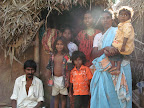About Ramavaram Slum


Click here to view in Google Earth (.kmz)
The slum is home to about 500 people living in 90 houses. Most of the adults have minimal or no educational background, and none of them have stable employment or an employable skill set. They have unsteady jobs which are highly vulnerable to fluxes in the local economy.
 Most of the women in the slum have minimal education and are illiterate. Married at young ages, they have migrated to the slum with their families. Many are very young mothers, and though they receive a modicum of health care, they are not knowledgeable about basic aspects of child care, nutrition, or family planning. Quite a few women do not receive adequate prenatal care and cannot acquire procedures such as cesarean sections.
Most of the women in the slum have minimal education and are illiterate. Married at young ages, they have migrated to the slum with their families. Many are very young mothers, and though they receive a modicum of health care, they are not knowledgeable about basic aspects of child care, nutrition, or family planning. Quite a few women do not receive adequate prenatal care and cannot acquire procedures such as cesarean sections.The children of the slum, who constitute about half of the population, live in an overcrowded area. Younger children run around the slum without any clothes and are visibly malnourished. Though many of the children go to school, most of them stop by the fifth standard of class and do not continue. Instead, they join the workforce and take on adult responsibilities at very young ages. They often do not receive the minimum of immunizations as recommended by the Indian Institute of Paediatrics. Some of them have unattended conditions requiring medical or surgical treatment such as chronic otitis media (ear infections) and cleft lips.
One of the major problems in the slum is basic sanitation and hygiene. They do not treat their water before using it for consumption. They receive it in a tank, provided by the government, which they use for cooking and drinking. However, for all other purposes - bathing, defecation, urination, handwashing, dishwashing and laundry - they use the river water, which represents a significant public health threat.
In our work at Ramavaram, we want to improve the health status and economic condition of the residents of the slum. We plan to promote the health status through education and through implementation of public health measures. We plan on improving the economic conditions of the community through the promotion of children's education as well as vocational training for the older residents. We have a number of programs currently in development and we hope we can make a significant difference in their lives.


1 Comments:
Hi Guys...This is Aarthi.M. I'm working as a Software Engg. Came to know the blog thru' Malarvizhi, my cousin.
I'm spellbound...Grt work by you guys...
I'd like to contribute in any way you guys want me to...first and foremost I'd write a blog (in my blog) about this... so that all my blog buddies get a chance to know about this followed by sending emails to all my contacts...Grt work guys....Keep Going...:)
Post a Comment
Subscribe to Post Comments [Atom]
<< Home